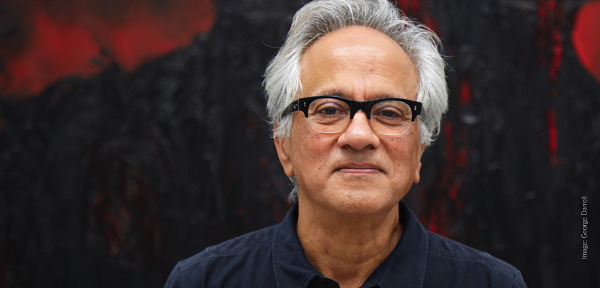THIE WEEK’S MUSE
ANISH KAPOOR, ARTIST

“We live in a fractured world. I’ve always seen it as my role as an artist to attempt to make wholeness.”
Anish Kapoor is a British-Indian sculptor specializing in installation and conceptual art, and in recent years on a monumental scale.
He was born in 1954, in Mumbai, a large city on the west coast of India, today it’s known as the financial commercial capital. He moved to Israel in 1971, initially studying engineering there. After finding the mathematics components “troubling” he dropped it, shifted tack entirely and moved to London to attend art college.
Kapoor has lived and worked in London since then, but the influence of Mumbai and Indian culture has remained an influence. Throughout his career his work has been informed by the vibrant markets, busy temples, and energetic streets of his youth – and in particular by the rich colors that surrounded him. “Red is a color I’ve felt very strongly about,” he said later. “Maybe red is a very Indian color, maybe it’s one of those things that I grew up with and recognize at some other level.”
Initial success and public attention came via the 1978 group exhibition New Sculpture at the Hayward Gallery in London. The show featured a number of artists, Kapoor included, aiming to break away from the minimalist styles and fashions of previous generations.
His early sculptures are often simple, curved forms, usually monochromatic and brightly colored. He would use raw pigment to define a form, letting it spill out beyond the object itself and onto the floor or surface. “While making the pigment pieces, it occurred to me that they all form themselves out of each other.”
In opposition, Kapoor also explored the idea of the void, creating a series of works that integrated constructions that receded into walls, disappeared into floors, or dramatically changed depth with a simple shift in perspective.
This manipulation of the—inside and outside—space around a sculpture has continued to be a preoccupation for Kapoor. A move to mirrored and reflective surfaces, and an ongoing shift towards ever-larger larger installations, have increased the spatial impact. And, significantly, on the viewer, spontaneously placed within the work.
“The work itself has a complete circle of meaning and counterpoint. And without your involvement as a viewer, there is no story.”
Although his colored sculptures may evoke a different response in the viewer to his large-scale mirrored installations, they are perhaps united by his fascination with “what is inside,” referring to both the viewer and the work. “What interests me is the sense of the darkness that we carry within us,” he said, “the darkness that’s akin to one of the principal subjects of the sublime – terror.”
He has “an obsession with red,” in particular Alizirin crimson, a color that he uses “by the ton.” It’s a very dark, blood-red color that, when linked to black, “makes great darkness.”
Part of his continuing ambition is to manipulate the form of the work and that of the space around it. In creating larger, monumental works, Kapoor began to integrate his sculpture and installations more fully within the surrounding environment, and more directly with the viewer. An essential component of his creativity. “There’s something imminent in the work,’ he said, “but the circle is only completed by the viewer.”
HAPPENING
Tuesday, May 16, 6–8pm

SPRINT MENU SERIES NIGHT 3
With Chef Joe Cizynski
Smoked veal sweetbreads, grilled lamb tenderloin kebabs, and much more!
Member: $65, Non-member: $75
